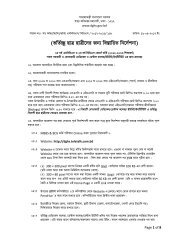EOC Newsletter June 2011
EOC Newsletter June 2011
EOC Newsletter June 2011
- No tags were found...
You also want an ePaper? Increase the reach of your titles
YUMPU automatically turns print PDFs into web optimized ePapers that Google loves.
Figure-8. Comparison of Case Fatality Rate (%) inEmOC facilities in the year 2008, 2009 and 20101.61.41.210.80.60.40.20BarisalChittagongDhakaKhulnaRajshahiRangpur2008 2009 2010Key FindingsIn Barisal and Chittagong divisions, the proportion of allbirths that took place in 2010 was below the minimumacceptable level of UN process indicator. This may indicatethat some women who needed live saving obstetric care didnot come to the health facility to receive the services(Figure-1).In Chittagong, Rajshahi and Rangpur divisions, the metneed (%) indicates lack of utilizing the facilities/ less referralby the community during the pregnancy relatedcomplications (Figure-2).Nationally substantial increase in institutional delivery rateswas found in 2010 compared to 2009 (Figure-5).The country's average performance for the year 2010 wasbetter in respect to met need (%) for EmOC compared toprevious two years, although in Khulna division, theperformance went a bit lower compared to that in Year 2009(Figure-6).The rates of cesarean sections in the year of 2010 weremore in all divisions compared to the year 2008 and 2009(Figure-7).In some divisions, namely in Khulna and Rajshahi, the casefatality rate was seen to improve, whereas in Rangpurdivision the situation progressed negetively in 2010 than in2009. In Barisal division, the situation remained unchangedin 2010 compared to 2009. The reason is subject to analyzeby the Reproductive Health Program (Figure-8).Limitation About the Data SourceSylhetBangladeshThe MIS-Health receives data from inadequate number ofprivate sources (NGOs and Private Hospitals or Clinics),although the coverage of public facilities is satisfactory. Thislimitation needs to be considered during evaluation of the report.RecommendationThe information reflected in the <strong>Newsletter</strong> has a potential scopeto analyze the EmOC services throughout the country. Thereproductive health program and other concerned may use theinformation to explore the reasons of good and badperformances and act upon it accordingly to improve the EmOCservices.ConclusionObstetric care seeking behavior of the women in Bangladesh isimproving as revealed by the increasing rate of institutionaldeliveries in the EmOC facilities. Ensuring availability of 24/7CEmOC services in the facilities is a big challenge. There isuneven distribution of service qualities in EmOC facilities amongdivisions of Bangladesh. Average case fatality rate in the EmOCfacilities of the country has been found to progress negetively in2010 compared to 2009, which needs attention.Editorial BoardAdvisors1 Professor Dr. Khondhaker Md. ShefyetullahDirector General of Health Services2 Dr. A.B.M. Jahangir AlamDirector, PHC & Line Director, ESD, DGHSChief Editor1 Professor Dr. Abul Kalam AzadDirector, MIS-Health, DGHSAssociate Editor1 Md. Ashraful Islam BabulDeputy Chief (Non -Medical), MIS-Health, DGHSAssistant Editor and Designer1 Md. TaufikuzzamanStatistician, MIS-Health, DGHS2 Nayeem Al MifthahGIS Consultant, MIS-Health, DGHSMembers1 Dr. Nasima AkhterChief, HIU, MIS -Health, DGHS2 Dr. Md. Shahjahan AliDeputy Director, MIS-Health, DGHS3 Dr. Md. Bashirul IslamAssistant Director, MIS -Health, DGHS4 Dr. M. A. Hannan BhuyianDeputy Program Manager, MIS-Health, DGHS5 Mr. Sukhendu Shekhor RoySystem Analyst , MIS-Health, DGHS6 Dr. Monira ParveenHealth Manager, UNICEF, Bangladesh7 Dr. Mohammad Khairul HasanHealth Officer, UNICEF, Bangladesh8 Dr. Sultan Shamiul BasharOSD, MIS-Health, DGHSComposer1 S. M. Rezaul HoqueAssistant Statistician, MIS-Health, DGHS07



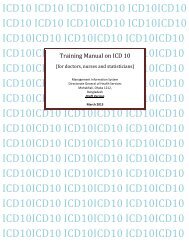



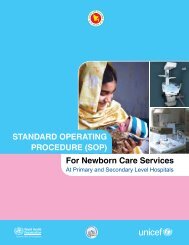
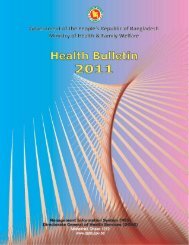
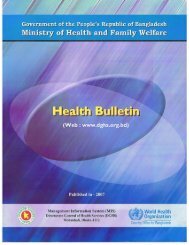
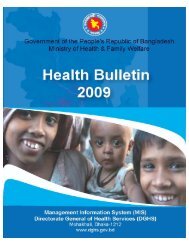
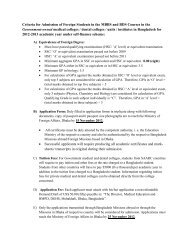
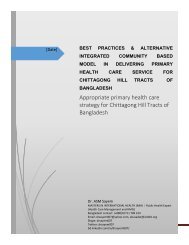
![Bangladesh Demographic and Health Survey 2007 [FR207]](https://img.yumpu.com/38440445/1/190x257/bangladesh-demographic-and-health-survey-2007-fr207.jpg?quality=85)
